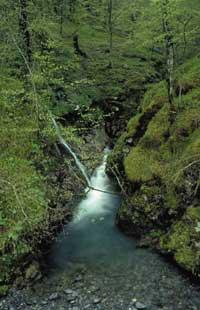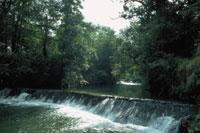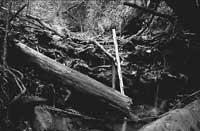The transformation of the rivers of Euskal Herria throughout history
1997/06/01 Arturo Elosegi Irurtia - Ekologiako katedradunaZientzia eta Teknologia Fakultatea. EHU Iturria: Elhuyar aldizkaria
Prehistory and Antiquity

The first major changes in the landscape of Euskal Herria produced by humanity took place in the Neolithic, with the arrival of livestock and agriculture. The ranchers burned the high mountains and turned them into pastures, initiating the deforestation process that followed at least until the Modern Age. Contrary to what many believe, the origin of the grasslands is an ancestral fact, as has been verified by analyzing the pollen of several deposits, in Gipuzkoa there were very few forests for the Iron Age, since both ferns and heath dominated.
With the elimination of the forest, the sources of energy in the streams are also altered: the disappearance of the litter that constituted the base of the community and the transformation of the algae in the main forage, which caused a great alteration of the fauna of invertebrates. Without shade, the water temperature increases and some cold water species that only live in the springs were lost or decreased. In addition, erosion increased considerably, which led to a progressive loss of water accumulation capacity in the basins, sharp drops in flows, and severe floods and droughts.

During the rains the rivers carried a lot of mud, causing the inertiation of the entrance of oxygen between the precious stones of the bottom and the destruction of the rules of many fish. All this caused problems to different species, especially of cold weather. This is the case of salmon: The Basque Country is close to the southern limit of the distribution of this species and is closely linked to fresh and transparent waters, which began to be lost in the Neolithic.
Although in Prehistory and Antiquity the main modelers of the landscape in Euskal Herria were the ranchers, we cannot forget the farmers, who also transformed quite a lot the plains.
The expansion of the agricultural lands was very slow, depending on the appearance of new techniques, but in the Iron Age already wheat was grown in the vegas of Gipuzkoa and, of course, in the south of Alava or Navarre. In fact, in some prehistoric sites, the importance of agriculture in areas such as Rioja is evident. In the arid regions of Euskal Herria, probably, the extensive lands of the banks would be used, once the native forests were cut. The importance of coastal forests is important, since in addition to being an essential habitat for many species, they control the structure of the bed and the quality of the waters. Fallen trunks form wooden dams offering burladeros for different animals and, in general, increasing the diversity of habitats. The logging of these forests was impoverishing the structure and communities of the rivers.
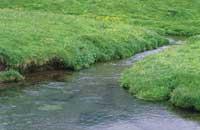
Another important change suffered by the rivers of Euskal Herria arid in Antiquity came from the hand of the Romans, who were the first to carry out water ductions, long channels, dams and aqueducts.
Middle Ages
The culture of ranchers and farmers that emerged in the Neolithic period and which spread through the Bronze and Iron Ages allowed to increase the population. The growing number of people and the effectiveness of technology made Euskal Herria suffer a great transformation in the Middle Ages.
Despite the few technological changes suffered by grazing, it grew for centuries and reached its maximum splendor at the end of the Middle Ages. The wool became the main resource of the Iberian Peninsula, so the ranchers, gathered in twins, gained a great strength. Among the remains of that time are the jungles and the pecuary tracks, but also the landscapes like the Bardenas, witnesses of the strong erosion, as the delta that was created in the area of the riverside or in the mouth of the River Ebro at the end of the Middle Ages.

The villages also grew notably in the Middle Ages. People lived in walled villas (Baiona, Elorrio or Puente la Reina, for example, have maintained the medieval structure in the old helmets), and since there were no purification systems, this type of batteries generated important pollution problems in many places. There is no more to remember the deaths from epidemics, many related to water. Since then it was not possible, therefore, to drink water from any river.
The agriculture experienced a great advance in the southern slope, since the Moors introduced important improvements in the irrigation systems, which caused a considerable increase in the crops that could be obtained from the arid lands close to the main rivers.
Grain production increased and the most rugged rivers and streams were filled with mills, as the main source of energy was water. They had great strategic importance and it is not surprising that the best mills were defended through tower houses, as shown by the examples that remain today. The mills had a great influence on the regattas, since most of the steep streams that until then had not been prescribed were covered with unsurpassed bars for fish. Salmon were abundant in the Ansar (many workers revolted because they only gave them food), but they began to decline rapidly due to dams, among other things.

With commerce, new forms of life and customs were spreading, and one of them influenced the communities of our slow rivers: the tent that grew in the monasteries as a substitute for meat came to the south of Europe during the Middle Ages. Biological pollution, therefore, has deep roots among us.
Modern Age
In the Modern Age came the biggest revolution that has known agriculture on the north side of Euskal Herria: the hamlet. XVI. In the eighteenth century corn, beans, potato and other plants were brought from America, which doubled or tripled the fertility of agricultural lands. Thanks to this, the lands that until then were unexploitable in the humid Basque Country were profitable and the ‘bordas’, houses far from the village and surrounded by fields were created or strengthened.
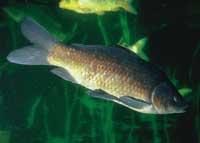
At first people lived in the village, but the overpopulation caused some families to move to live on the edge. Still in some places of Navarre have been repeated the names of many houses (the house Peustenea in the village and the hamlet Peustenea Borda), witness of those times. The deforestation of the northern slope knew the maximum level with the construction of hamlets everywhere. In the twentieth century. In addition, the conversion of large extensions of land into fields of cultivation allowed a strong erosion that left a mark on the rivers.
The rivers became increasingly important as a source of energy. Formerly it was only exploited in the mills, but over time the uses of the water force increased: fabrics, cordobanas, serrerías, ferrerías, etc. In any place where there was enough slope. Unlike what happened until then, the river bank began to fill with constructions, turning the canal into a dam and a waterfall chain.

Trade was also strengthened in the Modern Age and with it the importance of transport. Medium streams and rivers have traditionally been used for transportation. For this purpose not much was worked at the beginning, the bed was simply cleaned with trunks. Over time, however, more and more large boats were used, which caused problems, since the rivers were very variable and navigation was difficult. In this way, most of our great rivers changed radically: the meanders were eliminated, the flood plains were drained, the coastal wetlands were dried, the horseshoe lakes were covered, the bed was channeled, the bottom was dragged, the sand bars were removed, etc. As a result, these rivers have a much simpler and less diverse structure than before, and sometimes very artificial channels. It is the case of Aturri, who in his day went out to the sea in the Ancient Mouth, but in 1578 a new tour of Bayonne was made.
Contemporary Age

The Industrial Revolution left a deep mark in Euskal Herria. On the one hand, the old ferns and most mills were closed at the end of the last century and at the beginning of it, but the power plants occupied their place in the most steep streams (on both sides of the Pyrenees and in Gipuzkoa). Due to the need for a great leap in the generation of electricity, the long canals divert most of the water from the bed and the long stretches of many streams are left practically dry.
On the other hand, the industry brought with it enormous growth, especially in Gipuzkoa and Bizkaia. The paper and steel industry filled most of the floodplains of factories, and, with the joy of economic expansion, most of the streams in these territories stained with unknown levels of pollution in the world, with the joy of flooding factories. In addition to fish, most of the other living beings were exiled from the river forever.

However, industrial growth had greater consequences. While in the large villages of Bizkaia and Gipuzkoa the number of inhabitants increased considerably, the hamlets were emptied, changing the pine in the ancient closures and pastures. This means that today we have the largest forest area seen in Euskal Herria in the last 4,000 years. The management of these forests in many cases is very poor: too many slopes and worse, large bushes are made in steep areas, and sometimes there is a change before the next plantation, which has caused a strong erosion in many places. There is no more to look at the bottom of many rivers of Euskal Herria, since clay is often the main sediment.

In the middle of this century the industrialization in the plains of Lapurdi, Navarre and Alava revolutionized the cultivation thanks to new machines, chemical fertilizers, pesticides and techniques. One of the most notable consequences of modern agriculture has been the concentration of parcels, but also the excessive fertilization and contamination of pesticides in rivers.
Once the fertilizer reaches the water, the algae increase a lot, decreasing the quality of the water and causing discomfort to some animals. This diffuse pollution cannot be addressed through wastewater treatment plants, but the best solutions that are known are those related to the original structure of the river: the forests and wetlands of riverside, the sinuous and fun channels and the ferra lakes give the rivers a huge capacity of self-purification. Once they have disappeared, however, it is very difficult to avoid agricultural pollution.
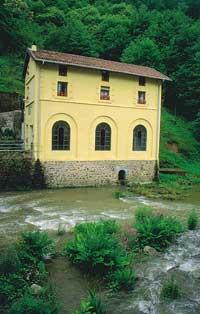
Another new element that this century has brought to our rivers are the large reservoirs like those of Esa, Añarbe or Uribarri. These substantially alter the structure of the river and its water regime. Those used for the supply of water leave a very low but constant flow in the river, while the producers of electricity, in addition to having strong decreases of flow once or twice a day, usually release water from the bottom, cold and often poor in oxygen.
This has reduced the transport of sediments and the frequency of floods, which has significantly influenced the soils of the flood plains. The delta of the Ebro, for example, is disappearing in recent decades, since in the large reservoirs the sediments necessary to maintain it remain.
The condition of the water supply can be analyzed in another section, since all springs have been filled with pipes, so the streams carry much less water than before, and they hardly have the capacity to dilute the pollution produced by the farmhouses or to retain aquatic living beings.
The floodplains are dangerous zones in the rains, so previously no houses were built. However, the location of mills and ferns on the bank of the river has been indispensable, and little by little these areas were occupied by constructions; in the last two centuries the water shore has been the chosen place to build factories and houses.

By increasing flood damage (not the magnitude of the floods) the rivers have been channeled and dredged in search of a “perfect” hydraulic operation. However, with this, its biological function has deteriorated, breaking the relationship between the river and the flood plain, limiting the capacity of self-purification and eliminating the refuges of living beings of the rivers.
Among the changes that have occurred in the Contemporary Age, it is also worth mentioning the biological pollution, which, although as has already been mentioned above, in the last century has aggravated the influence of exotic species, driven by people (the case of pike and American perch) or not (the cotale, the American vison). The pike has had a great influence on the populations of local fish and the decline of the water flake in several points of the Peninsula has been attributed to the American vison. At the request of fishermen, many streams have been supplied with fish from fish farming. In some cases foreign species (mainly rainbow trout) and in other external varieties have been used. In Bizkaia, for example, Norwegian trout has been released for many years, eliminating local genotypes adapted to different streams.

In recent times new performances have been generated and the new uses of the medium have supposed an alteration of the fluvial landscapes. The cage, rafting, green tourism and other activities with increasingly quirky names have become fashionable and many rivers are adapting to them. Of course, some changes can be beneficial.
Likewise, as a reflection of today's green mentality, some rivers have been protected: Forests of several banks of Navarre or the Gipuzkoan area of the Leitzaran River. It remains to be seen the influence of these protective formulas, but it must be taken into account that the flow of water to keep the river healthy must undergo variations, which is very difficult with the current form of exploitation.
Future of the future
Given the high resilience of rivers and streams, the future is partly in our hands. It is very representative to observe how the rivers most punished by pollution have been recovered as a result of the industrial crisis.

In Oria and Urola, for example, in the rivers that twenty years ago were only sewers with bad smells, today there are fish and other animals. This has great importance in the perception of the landscape and in the relationship of people with the environment.
The laws of the European Union will also bring great changes to our rivers and the quality of the waters will improve thanks to the purification of the waters. However, the problem of agricultural pollution will not be solved so easily, since we have barely left room to reform the coastal forests.

In other countries (Germany, England and Denmark) it has begun to work on improving the functioning of the rivers by planting silts, rebuilding meanders and other actions, while in Euskal Herria little has been done.
As mentioned above, rivers are very dynamic systems that respond to the changes that occur in the basin. Society is continually creating new forms of exploitation of the environment, and rivers will witness these changes.

It is urgent to use different uses (e.g. : the combination of fishing, leisure, water supply, navigation, etc., since many times it is very possible that slightly reducing the main use (the production of electricity, for example) occurs a significant increase in the performance of others (such as fishing). The high natural variability of rivers allows them a faster response than other ecosystems, which allows us to observe the positive results of good management much earlier.

Gai honi buruzko eduki gehiago
Elhuyarrek garatutako teknologia



